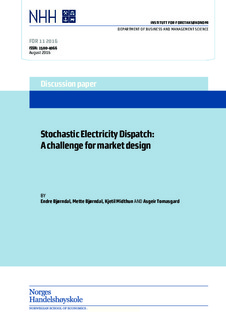Stochastic Electricity Dispatch: A challenge for market design
Working paper

Åpne
Permanent lenke
http://hdl.handle.net/11250/2401590Utgivelsesdato
2016-08-25Metadata
Vis full innførselSamlinger
- Discussion papers (FOR) [566]
Sammendrag
We consider an electricity market with two sequential market clearings, for instance representing a day-ahead and a real-time market. When the first market is cleared, there is uncertainty with respect to generation and/or load, while this uncertainty is resolved when the second market is cleared. We compare the outcomes of a stochastic market clearing model, i.e. a market clearing model taking into account both markets and the uncertainty, to a myopic market model where the first market is cleared based only on given bids, and not taking into account neither the uncertainty nor the bids
in the second market. While the stochastic market clearing gives a solution with a higher total social welfare, it poses several challenges for market design. The stochastic dispatch may lead to a dispatch where the prices deviate from the bid curves in the first market. This can lead to incentives for selfscheduling, require producers to produce above marginal cost and consumers to pay above their marginal value in the first market. Our analysis show that the wind producer has an incentive to deviate from the system optimal plan in both the myopic and stochastic model, and this incentive is particularly strong under the myopic model. We also discuss how the total social
welfare of the market outcome under stochastic market clearing depends on the quality of the information that the system operator will base the market clearing on. In particular, we show that the wind producer has an incentive to misreport the probability distribution for wind.